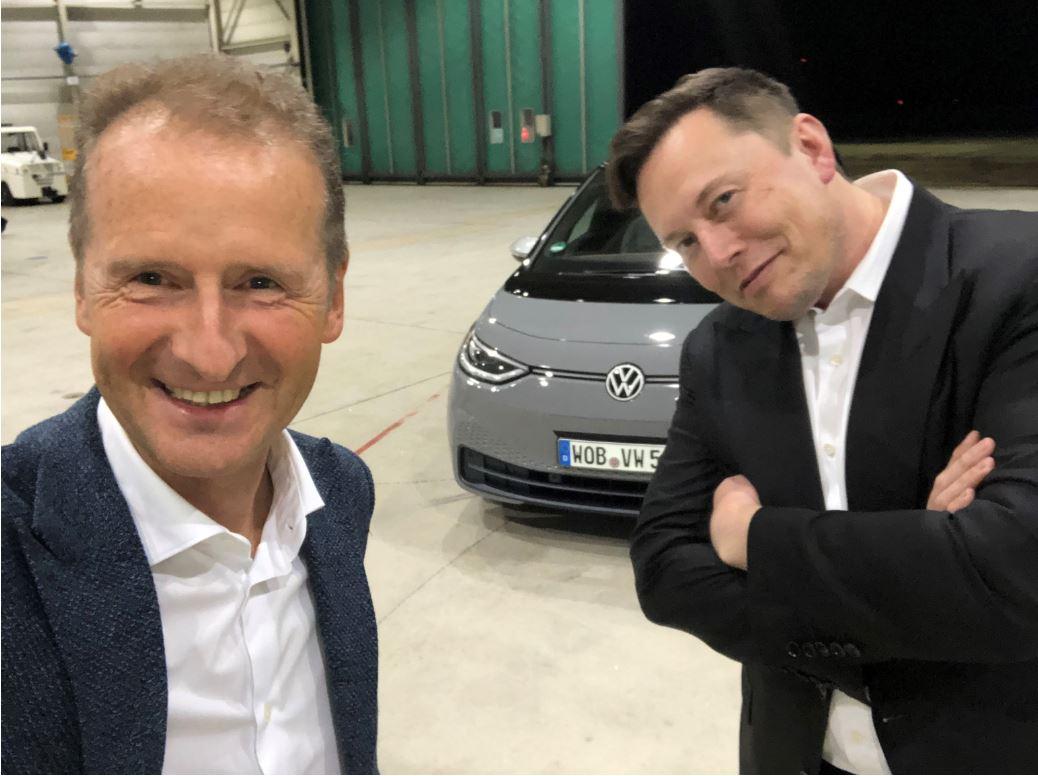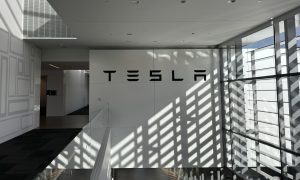Volkswagen Auto Group CEO Herbert Diess has led his German car company to be one of the most respected in terms of large entities that have chosen to leave a long and successful past of producing gas-powered vehicles in favor of electrified models. Diess has worked long and hard to dissolve VW’s past mistakes, especially the Dieselgate scandal from several years ago. However, in 2021, VW has left its blemished past behind it and is the most popular electrified brand in Europe, leading companies like Tesla, Peugeot, and Renault in the world’s most robust market for electrified vehicles. Diess is a big part of this accomplishment and has one of the more keen eyes for the industry, self-admittedly behind Elon Musk.
Diess’ thoughts on the EV industry and how 2021 has shaped it to be one of the most difficult and challenging sectors of the year due to semiconductor shortages, along with his plans for Volkswagen’s electrified future and his respect for fellow auto CEO Elon Musk were discussed in a recent interview with CNN’s Anna Stewart who caught up with the VW frontman at the International Motor Show in Munich.
50% of sales electric by 2030
Diess responds to Stewart’s first inquiry, which regards VW’s goal to have 50% of its sales be electric by 2030. “In Europe, we are already leading,” Diess said, which is true based on the most recent figures from EU-EVs.com, showing Volkswagen has a comfortable lead over second-place Tesla by just over 20,000 vehicles. In other markets, Volkswagen is performing well. “Even in the US, we have been in second place for the last months, and in China, we are growing fast. We think we will become the market leader for EVs,” Diess adds.
Volkswagen has absolutely taken on the EV initiative better than 99% of other car companies, making its goals the most believable moving forward. The ID. family of vehicles has performed incredibly well, with Volkswagen offering specific models for specific markets to keep things fresh, exciting, and relevant. The question is, will VW be able to keep up its domination of the European market when Tesla begins production at Giga Berlin later this year?
Global semiconductor shortage
One of the biggest bottlenecks in recent history, the global semiconductor supply shortage, has plagued automakers to scrap basic functions like “push-to-start” features in ICE vehicles. Diess, a usually optimistic person, admits that Volkswagen is still struggling with the shortages, and he is not quite sure when things will get better.
“It has gotten worse already. We expected that we would have relief after the summer break, which didn’t happen because, in Malaysia, we had really quite significant problems with Covid,” Diess added. “Some of our suppliers, the back ends of our suppliers are mostly based in Malaysia, and three plants were hit hard. We think that we will overcome this situation towards the end of the month, and then we should see relief.”
Autonomy
In terms of autonomy, Diess is optimistic about the capabilities of self-driving cars. “We see a much bigger transition for the industry when cars are becoming autonomous because cars will be used differently, used by more people. You can send your children or your grandparents in a car somewhere. Now imagine!” Volkswagen previously claimed it could sell a self-driving system that charged by the hour, and it would be profitable doing it. However, Diess said the business still has a long way to go, and Volkswagen will likely roll out its first fleet in 2024 or 2026. “But it’s now time to invest and to prepare. And that’s what we are doing,” he stated.
Volkswagen says it can profitably sell a self-driving system for €7 an hour
Volkswagen vs. Tesla
Diess holds high regard for Tesla CEO Elon Musk. The two are friends and have shared several compliments with each other on several occasions. Musk even took a ride in an ID.3 in Germany with Diess piloting the vehicle, which ignited rumors of a potential collaboration between the two automotive CEOs. Diess still holds the utmost respect for Musk and Tesla, calling the company’s frontman “a brilliant guy” who “makes a difference. He’s changing the world with his ventures.”
Despite the two companies combating to dominate EV sales across the globe, Diess does not see any parallels between VW and Tesla. “We are quite different. He is very focused on Tesla, on his story. I’m running a big traditional company, which we try to prepare for the future. And I think we also require different characters. I like him a lot, but I think we are quite different.”
As for whether Diess was ever offered the CEO job at Tesla, Herbert simply ended with, “I don’t know,” and a slight chuckle.”
What do you think? Let us know in the comments below, or be sure to email me at joey@teslarati.com or on Twitter @KlenderJoey.
News
Tesla begins Robotaxi certification push in Arizona: report
Tesla seems serious about expanding its Robotaxi service to several states in the coming months.

Tesla has initiated discussions with Arizona transportation regulators to certify its driverless Robotaxi service in the state, as per a recent report from Bloomberg News. The move follows Tesla’s launch of its Robotaxi pilot program in Austin, Texas, as well as CEO Elon Musk’s recent comments about the service’s expansion in the Bay Area.
The Arizona Department of Transportation confirmed to Bloomberg that Tesla has reached out to begin the certification process for autonomous ride-sharing operations in the state. While details remain limited, the outreach suggests that Tesla is serious about expanding its driverless Robotaxi service to several territories in the coming months.
The Arizona development comes as Tesla prepares to expand its service area in Austin this weekend, as per CEO Elon Musk in a post on X. Musk also stated that Tesla is targeting the San Francisco Bay Area as its next major market, with a potential launch “in a month or two,” pending regulatory approvals.
Tesla first launched its autonomous ride-hailing program on June 22 in Austin with a small fleet of Model Y vehicles, accompanied by a Tesla employee in the passenger seat to monitor safety. While still classified as a test, Musk has said the program will expand to about 1,000 vehicles in the coming months. Tesla will later upgrade its Robotaxi fleet with the Cyercab, a two-seater that is designed without a steering wheel.
Sightings of Cybercab castings around the Giga Texas complex suggests that Tesla may be ramping the initial trial production of the self-driving two-seater. Tesla, for its part, has noted in the past that volume production of the Cybercab is expected to start sometime next year.
In California, Tesla has already applied for a transportation charter-party carrier permit from the state’s Public Utilities Commission. The company is reportedly taking a phased approach to operating in California, with the Robotaxi service starting with pre-arranged rides for employees in vehicles with safety drivers.
News
Tesla sets November 6 date for 2025 Annual Shareholder Meeting
The automaker announced the date on Thursday in a Form 8-K.

Tesla has scheduled its 2025 annual shareholder meeting for November 6, addressing investor concerns that the company was nearing a legal deadline to hold the event.
The automaker announced the date on Thursday in a Form 8-K submitted to the United States Securities and Exchange Commission (SEC). The company also listed a new proposal submission deadline of July 31 for items to be included in the proxy statement.
Tesla’s announcement followed calls from a group of 27 shareholders, including the leaders of large public pension funds, which urged Tesla’s board to formally set the meeting date, as noted in a report from The Wall Street Journal.
The group noted that under Texas law, where Tesla is now incorporated, companies must hold annual meetings within 13 months of the last one if requested by shareholders. Tesla’s previous annual shareholder meeting was held on June 13, 2024, which placed the July 13 deadline in focus.
Tesla originally stated in its 2024 annual report that it would file its proxy statement by the end of April. However, an amended filing on April 30 indicated that the Board of Directors had not yet finalized a meeting date, at least at the time.
The April filing also confirmed that Tesla’s board had formed a special committee to evaluate certain matters related to CEO Elon Musk’s compensation plan. Musk’s CEO performance award remains at the center of a lengthy legal dispute in Delaware, Tesla’s former state of incorporation.
Due to the aftermath of Musk’s legal dispute about his compensation plan in Delaware, he has not been paid for his work at Tesla for several years. Musk, for his part, has noted that he is more concerned about his voting stake in Tesla than his actual salary.
At last year’s annual meeting, TSLA shareholders voted to reapprove Elon Musk’s compensation plan and ratified Tesla’s decision to relocate its legal domicile from Delaware to Texas.
Elon Musk
Grok coming to Tesla vehicles next week “at the latest:” Elon Musk
Grok’s rollout to Tesla vehicles is expected to begin next week at the latest.

Elon Musk announced on Thursday that Grok, the large language model developed by his startup xAI, will soon be available in Tesla vehicles. Grok’s rollout to Tesla vehicles is expected to begin next week at the latest, further deepening the ties between the two Elon Musk-led companies.
Tesla–xAI synergy
Musk confirmed the news on X shortly after livestreaming the release of Grok 4, xAI’s latest large language model. “Grok is coming to Tesla vehicles very soon. Next week at the latest,” Musk wrote in a post on social media platform X.
During the livestream, Musk and several members of the xAI team highlighted several upgrades to Grok 4’s voice capabilities and performance metrics, positioning the LLM as competitive with top-tier models from OpenAI and Google.
The in-vehicle integration of Grok marks a new chapter in Tesla’s AI development. While Tesla has long relied on in-house systems for autonomous driving and energy optimization, Grok’s integration would introduce conversational AI directly into its vehicles’ user experience. This integration could potentially improve customer interaction inside Tesla vehicles.
xAI and Tesla’s collaborative footprint
Grok’s upcoming rollout to Tesla vehicles adds to a growing business relationship between Tesla and xAI. Earlier this year, Tesla disclosed that it generated $198.3 million in revenue from commercial, consulting, and support agreements with xAI, as noted in a report from Bloomberg News. A large portion of that amount, however, came from the sale of Megapack energy storage systems to the artificial intelligence startup.
In July 2023, Musk polled X users about whether Tesla should invest $5 billion in xAI. While no formal investment has been made so far, 68% of poll participants voted yes, and Musk has since stated that the idea would be discussed with Tesla’s board.
-

 Elon Musk1 week ago
Elon Musk1 week agoTesla investors will be shocked by Jim Cramer’s latest assessment
-

 Elon Musk3 days ago
Elon Musk3 days agoElon Musk confirms Grok 4 launch on July 9 with livestream event
-

 Elon Musk17 hours ago
Elon Musk17 hours agoxAI launches Grok 4 with new $300/month SuperGrok Heavy subscription
-

 News7 days ago
News7 days agoTesla Model 3 ranks as the safest new car in Europe for 2025, per Euro NCAP tests
-

 Elon Musk2 weeks ago
Elon Musk2 weeks agoA Tesla just delivered itself to a customer autonomously, Elon Musk confirms
-

 Elon Musk1 week ago
Elon Musk1 week agoxAI’s Memphis data center receives air permit despite community criticism
-

 Elon Musk2 weeks ago
Elon Musk2 weeks agoTesla’s Omead Afshar, known as Elon Musk’s right-hand man, leaves company: reports
-

 News2 weeks ago
News2 weeks agoXiaomi CEO congratulates Tesla on first FSD delivery: “We have to continue learning!”















